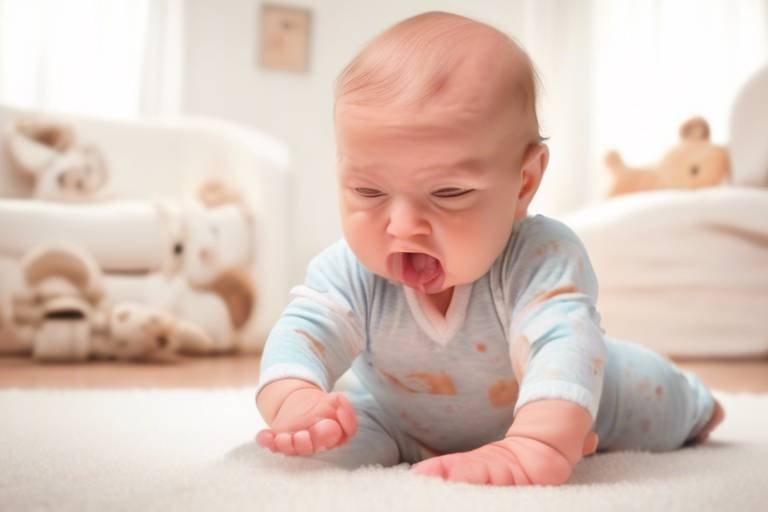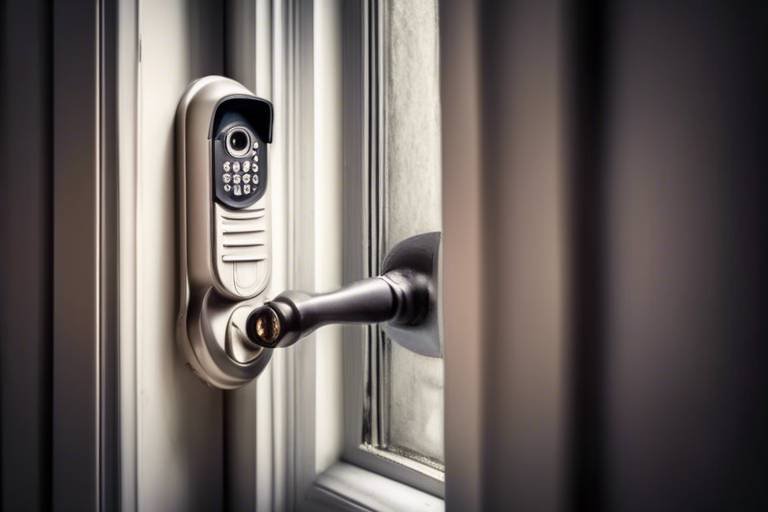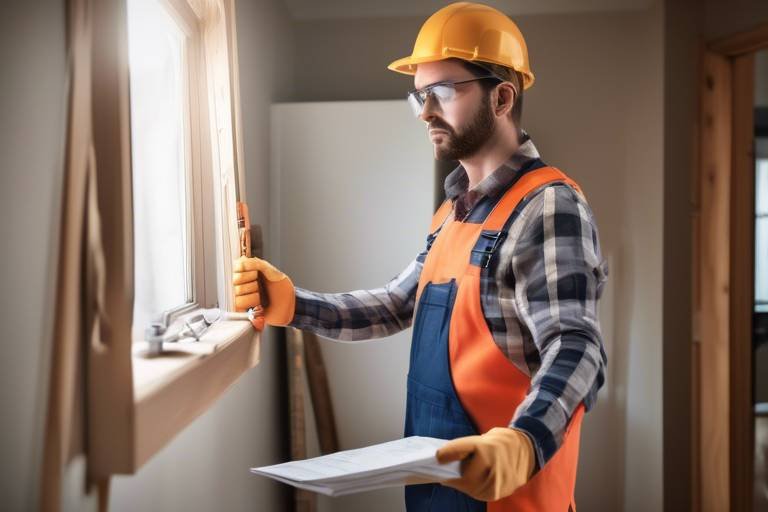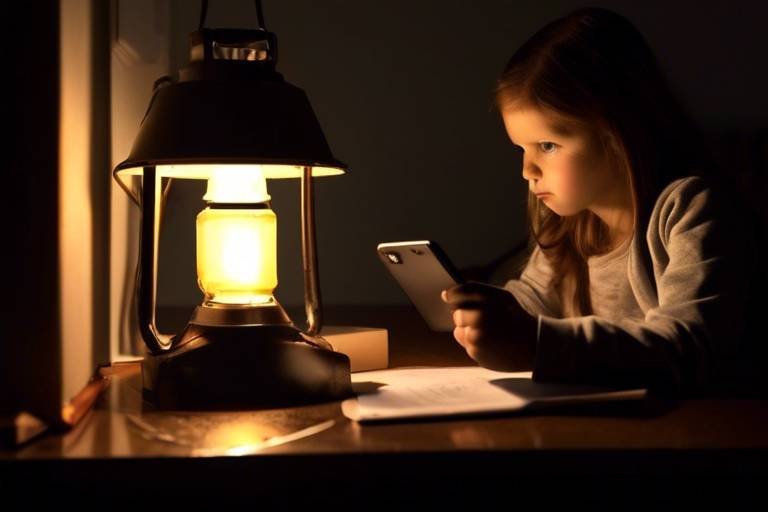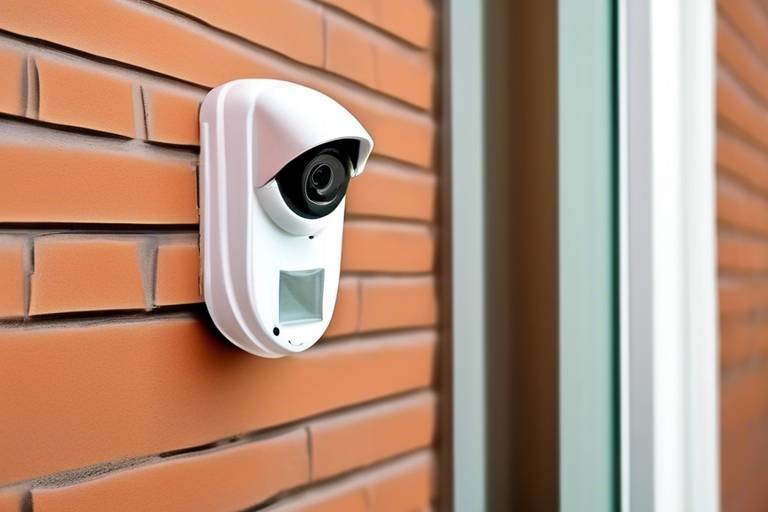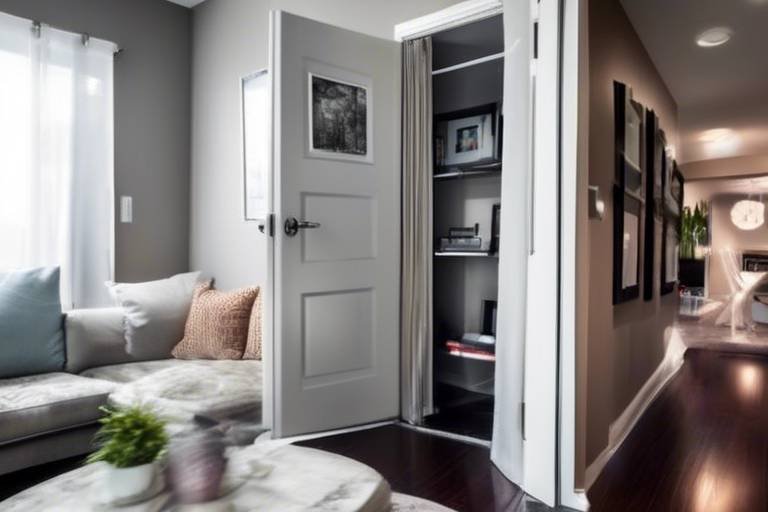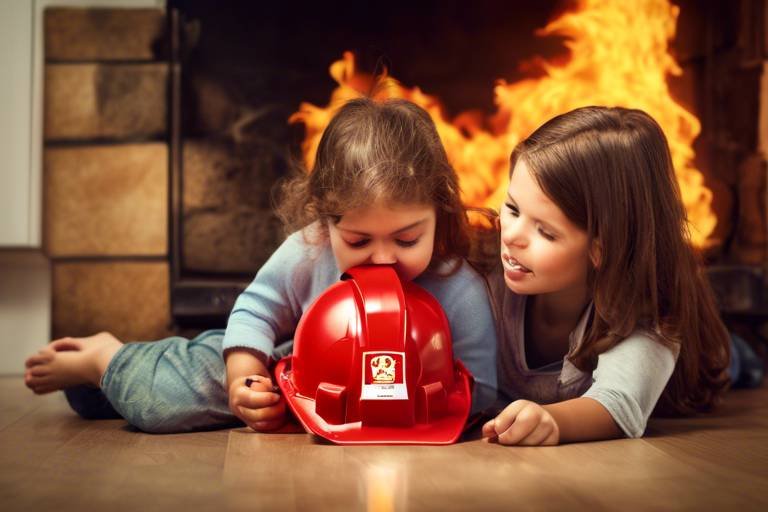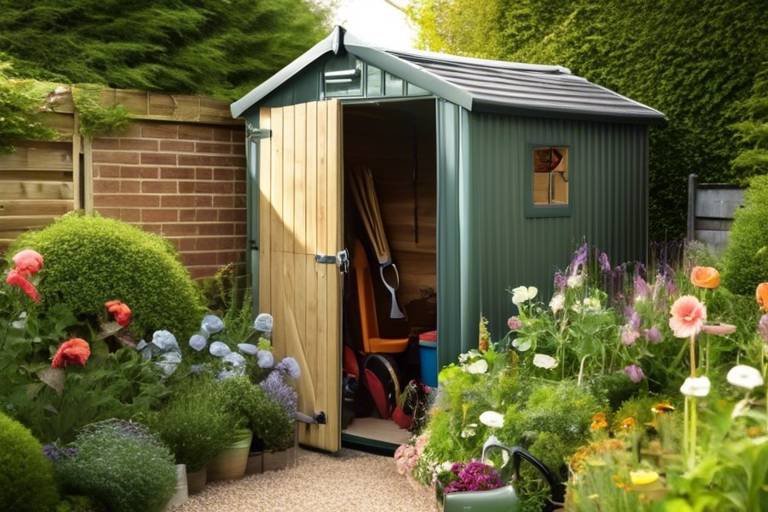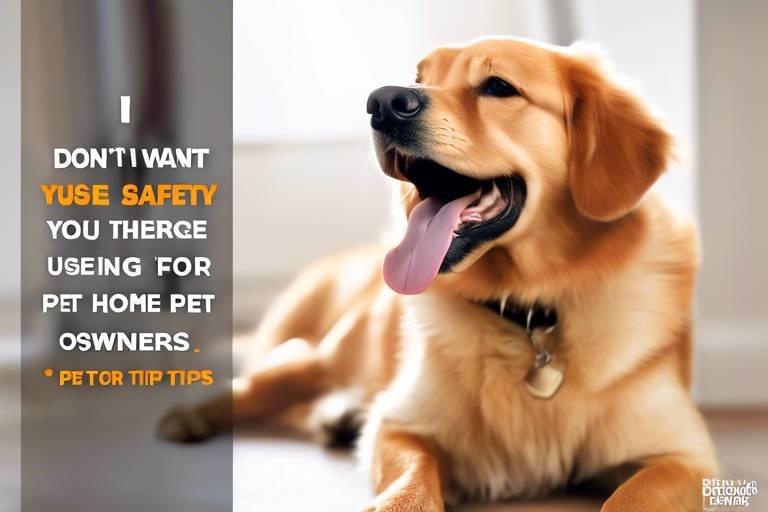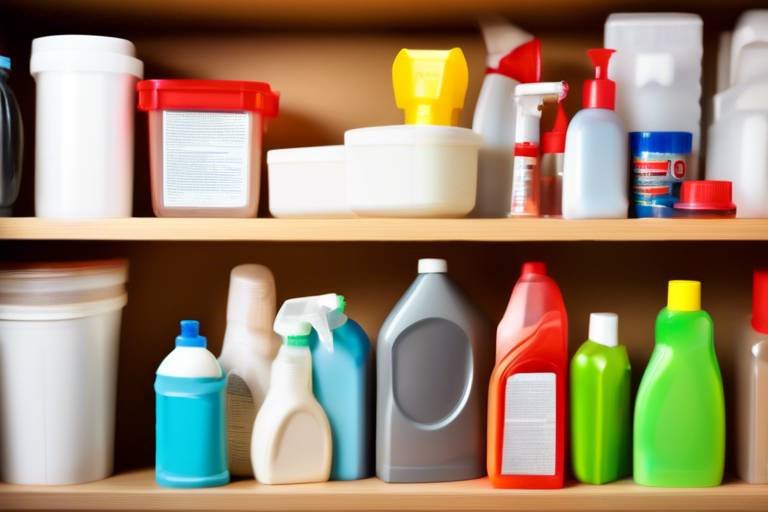How to Keep Your Baby Safe at Home
As a new parent, the world can feel overwhelming, especially when it comes to ensuring your little one is safe at home. The moment you bring your baby home, your instinct is to protect them from every possible danger. It’s like living in a constant state of alertness, isn’t it? You want to create a haven where your baby can explore and grow without the looming threat of accidents. This article provides essential tips and guidelines for creating a safe environment for your baby at home, ensuring their well-being as they explore their surroundings.
First things first, let’s dive into the fundamental items you’ll need to babyproof your home. Think of babyproofing as setting up a fortress around your little explorer. You’ll want to invest in safety gates to block off stairs or any dangerous areas, outlet covers to keep tiny fingers away from electrical sockets, and corner protectors to soften sharp edges on furniture. These essentials are your first line of defense against potential hazards. Remember, it’s not just about what your baby can reach, but also about creating a safe environment where they can learn to crawl, walk, and eventually run without fear. Here’s a quick overview of some must-have babyproofing items:
- Safety Gates: Perfect for keeping your baby out of rooms that aren’t baby-friendly.
- Outlet Covers: Simple yet effective in preventing electrical shocks.
- Corner Protectors: Softening those sharp edges can save you from a lot of tears.
- Cabinet Locks: Essential for securing harmful substances away from curious hands.
When it comes to sleep, ensuring your baby's safety is paramount. You might have heard about Sudden Infant Death Syndrome (SIDS), and it’s a concern that weighs heavily on every parent’s mind. To reduce the risk of SIDS, adhering to safe sleeping practices is crucial. This includes placing your baby on their back to sleep, using a firm mattress in a safety-approved crib, and keeping the room at a comfortable temperature. Let’s break down these practices further.
Choosing a crib is not just about aesthetics; it’s about safety. A safe crib should have sturdy construction, slats that are no more than 2 3/8 inches apart, and a mattress that fits snugly without any gaps. Compliance with safety standards is non-negotiable. It’s like finding the right shield for your little knight. When you ensure these features, you’re creating a secure sleeping area where your baby can rest peacefully.
While it might be tempting to dress up your baby's crib with adorable accessories, some of them can pose significant risks. Accessories like bumper pads, loose bedding, and stuffed animals can increase the risk of suffocation or entrapment. Instead, consider safer alternatives, such as a fitted sheet and a sleep sack. Your baby's safety is worth more than any cute accessory!
Keeping an eye on your baby while they sleep can be challenging, especially when you have chores to do. This is where baby monitors come in handy. They allow you to check on your little one without hovering over them constantly. Regular checks are also essential to ensure that their sleep environment remains safe. Think of it as a safety net, giving you peace of mind while your baby drifts off to dreamland.
Now, let’s talk about playtime! A designated play area is essential for your baby’s development. This space should be free from hazards, featuring soft surfaces and age-appropriate toys. Supervision is key here; it’s like being the director of a play, ensuring everything runs smoothly. Encourage exploration while keeping a watchful eye to prevent accidents. Remember, a little mess is a sign of a happy baby!
The kitchen is often considered the heart of the home, but it can also be a danger zone for a curious baby. From sharp utensils to hot surfaces, there are many potential hazards. Securing cabinets with childproof locks, using stove guards, and keeping harmful substances out of reach are vital steps to protect your baby from injuries. It’s like creating a safe haven within the chaos of cooking and preparing meals.
Proper food storage is equally important. Ensure that choking hazards are kept out of reach and that all food items are stored securely. It’s not just about keeping your baby safe; it’s also about teaching them the importance of food safety as they grow. A little preparation can go a long way in preventing accidents.
Don’t forget about childproofing kitchen appliances! Ovens, dishwashers, and microwaves can pose serious risks. Consider using appliance locks and keep the kitchen off-limits when you’re cooking. It’s all about creating boundaries that keep your little one safe while still allowing you to whip up delicious meals.
The bathroom is another area where safety is crucial. Non-slip mats can prevent falls, and toilet locks can keep curious hands away from the water. Supervision during bath time is essential to ensure a safe and enjoyable experience. Remember, water can be both fun and dangerous, so always stay close to your baby while they splash around.
1. What are the most common babyproofing items I should consider?
Some key items include safety gates, outlet covers, cabinet locks, and corner protectors.
2. How can I ensure my baby's sleep environment is safe?
Use a firm mattress, avoid loose bedding, and always place your baby on their back to sleep.
3. What should I avoid putting in my baby's crib?
Avoid bumper pads, stuffed animals, and loose blankets to reduce the risk of suffocation.
4. How can I make my kitchen safe for my baby?
Use childproof locks on cabinets, install stove guards, and keep harmful substances out of reach.
5. What are some bathroom safety tips for babies?
Use non-slip mats, install toilet locks, and always supervise your baby during bath time.

Babyproofing Essentials
When it comes to ensuring your little one's safety, babyproofing your home is not just a task; it's a necessity. Imagine your baby as an adventurous explorer, eager to discover every nook and cranny of their environment. As they crawl, pull up, and eventually walk, the world around them becomes a playground filled with both wonder and potential hazards. To create a safe haven for your baby, you need to invest in some essential babyproofing items that will help minimize risks and give you peace of mind.
First up on the list is safety gates. These handy barriers are perfect for keeping your baby out of rooms or areas that may pose a danger, like staircases or kitchens. When choosing a safety gate, look for one that is sturdy and can be securely mounted to walls. You want to ensure it’s tall enough to prevent your little one from climbing over it. Remember, a good safety gate is like a superhero's shield, protecting your baby from unexpected tumbles!
Next, let’s talk about outlet covers. Electrical outlets can be a major hazard for curious babies who love to explore. By installing outlet covers, you can effectively block access to these potential shock zones. It's a simple yet effective way to keep those tiny fingers safe. Think of outlet covers as tiny guards standing watch over your electrical outlets, ensuring no little hands accidentally find their way in.
Another essential item is corner protectors. Sharp corners on furniture can be quite dangerous, especially as your baby starts to pull up and navigate their surroundings. Installing soft corner protectors can cushion those edges, reducing the risk of bumps and bruises. It's like giving your furniture a cozy blanket—making it safer for your little explorer!
Don't forget about securing furniture to the wall. As babies start to pull themselves up, they might inadvertently tip over bookshelves, dressers, or TV stands. Use anti-tip straps to anchor these items to the wall, preventing any potential disasters. It’s a small step that can make a huge difference in keeping your baby safe.
Additionally, consider using cabinet locks. Babies are naturally curious, and kitchen cabinets can be a treasure trove of dangers—from sharp utensils to cleaning supplies. Installing cabinet locks will help keep those curious little hands away from potentially harmful items. Think of these locks as the gatekeepers of your kitchen, ensuring that only safe items are within reach.
Lastly, a well-stocked first-aid kit is a must-have. Accidents happen, and being prepared can make all the difference. Make sure to include items like band-aids, antiseptic wipes, and any medications your baby may need. It’s like having your own emergency room at home, ready to tackle any bumps along the way.
In summary, babyproofing your home is all about creating a safe environment for your little one to explore without fear. By investing in safety gates, outlet covers, corner protectors, furniture anchors, cabinet locks, and a first-aid kit, you can ensure that your home is a secure place for your baby. Remember, safety is not just an option; it’s a priority. So gear up, babyproof your home, and watch your little explorer thrive!
- What is the best age to start babyproofing? It's best to start babyproofing before your baby begins to crawl, which is typically around 6 to 10 months old.
- Are all babyproofing products safe? Not all products are created equal. Look for items that meet safety standards and are recommended by parenting experts.
- How often should I check my babyproofing? Regularly inspect your babyproofing measures, especially as your child grows and becomes more mobile. Adjustments may be necessary as they reach new milestones.

Safe Sleeping Practices
Creating a safe sleep environment for your baby is one of the most critical responsibilities you have as a parent. You want to ensure that your little one is not only comfortable but also protected from potential hazards while they slumber. Did you know that the right sleeping practices can significantly reduce the risk of Sudden Infant Death Syndrome (SIDS)? It's essential to be proactive and informed about how to set up a safe sleeping area.
First and foremost, crib safety is paramount. When choosing a crib, you should look for one that meets current safety standards. A sturdy construction is essential, so avoid cribs with drop sides, as these can pose a risk of entrapment or falls. Ensure that the mattress fits snugly in the crib, leaving no gaps where your baby could get stuck. Remember, a well-fitted mattress not only provides comfort but also safety!
When it comes to selecting a crib, there are several features you should consider. Look for cribs that are certified by recognized safety organizations. A safe crib should have:
- Sturdy construction: Ensure the crib is made from solid wood or high-quality materials.
- Proper mattress fit: The mattress should be firm and fit tightly against the crib sides.
- Adjustable mattress height: This feature allows you to lower the mattress as your baby grows and becomes more mobile.
Additionally, be cautious about crib accessories. Many parents are unaware that some items can actually create risks in the crib. For instance, items like bumper pads, loose bedding, and stuffed animals can increase the risk of suffocation or entrapment. Instead, opt for a fitted sheet and a sleep sack to keep your baby warm without compromising their safety.
It's crucial to be aware of common crib accessories that can pose risks. Here are some items you should avoid:
- Bumper pads: While they may seem cozy, they can lead to suffocation.
- Loose bedding: Blankets and pillows can obstruct your baby's breathing.
- Stuffed animals: These can become hazards as your baby moves around in the crib.
Instead of these items, consider safer alternatives, such as sleep sacks or wearable blankets, which keep your baby warm without the risk of suffocation.
To ensure your baby's sleep environment remains safe, consider using a baby monitor. This allows you to keep an eye (or ear) on your little one while you attend to other tasks around the house. Regularly check in on your baby, especially during their first few months, to ensure they are sleeping safely and soundly.
Another important aspect of safe sleeping practices is maintaining an appropriate room temperature. The ideal temperature for your baby's room is between 68°F and 72°F (20°C to 22°C). Keeping the room at this temperature helps to prevent overheating, which is another risk factor for SIDS. You can use a room thermometer to monitor the temperature easily.
In conclusion, creating a safe sleep environment for your baby involves careful consideration of their crib setup, the accessories you choose, and ongoing monitoring. By taking these precautions, you can provide a peaceful and secure sleeping space for your little one, allowing them to dream safely while you rest easy knowing you’ve done your best to protect them.
Q: What is the safest sleep position for my baby?
A: The safest sleep position for your baby is on their back. This position significantly reduces the risk of SIDS.
Q: When can I start using blankets in the crib?
A: It is recommended to avoid using blankets in the crib until your baby is at least 12 months old. Instead, use a sleep sack or wearable blanket.
Q: How can I tell if my baby is too hot while sleeping?
A: Check if your baby is sweating or feels hot to the touch. If they are, you may need to lower the room temperature or remove layers of clothing.

Choosing the Right Crib
When it comes to ensuring your baby's safety, is one of the most crucial decisions you'll make. A crib is not just a piece of furniture; it's a sanctuary where your little one will spend countless hours sleeping and dreaming. Therefore, it’s essential to consider several factors that contribute to a secure sleeping environment. First and foremost, look for a crib that meets current safety standards. Organizations like the Consumer Product Safety Commission (CPSC) have established guidelines that manufacturers must follow. These include having a sturdy construction with no loose parts, ensuring the slats are no more than 2 3/8 inches apart, and making sure the mattress fits snugly within the crib frame.
Another important aspect is the mattress. The right mattress should be firm and fit tightly against the sides of the crib to prevent any gaps where your baby could get stuck. Soft mattresses can pose a suffocation risk, so it’s best to steer clear of overly plush options. When shopping for a crib, consider whether you want a convertible model. These cribs can transform into toddler beds or daybeds, which can save you money in the long run and adapt as your child grows.
Don’t forget about the design and materials used in the crib. Opt for cribs made from non-toxic finishes and materials to ensure your baby is not exposed to harmful chemicals. Additionally, check for any sharp edges or points that could pose a danger. A well-designed crib will have rounded edges and smooth surfaces, minimizing the risk of injury during those wobbly, exploratory moments.
As you make your decision, consider the space you have available in your home. Cribs come in various sizes, so measure the area where you plan to place the crib to ensure it fits comfortably without crowding the room. A crib that’s too large can make the space feel cramped, while one that’s too small may not provide enough room for your baby to grow. When you find the right crib, it’s like discovering a hidden gem that not only fits your style but also keeps your baby safe.
Lastly, always remember to regularly check your crib for any signs of wear and tear. Over time, screws may loosen, or parts may become damaged. A quick inspection can go a long way in maintaining a safe sleeping environment for your baby. In summary, choosing the right crib is about balancing safety, comfort, and practicality. With the right crib, you can rest easy knowing that your baby is secure and sound while they sleep.
What should I look for in a crib?
When selecting a crib, ensure it meets safety standards, has a firm mattress that fits snugly, and is made from non-toxic materials.
Are convertible cribs worth it?
Yes! Convertible cribs can be a cost-effective solution as they grow with your child, transforming into toddler beds or daybeds.
How often should I check my crib for safety?
It's a good idea to check your crib regularly for any loose screws or wear and tear, ideally every few months.

Crib Accessories to Avoid
When it comes to creating a safe sleeping environment for your baby, it's crucial to be aware of the crib accessories that can pose potential risks. Many well-meaning parents may not realize that certain items, while seemingly harmless, can actually jeopardize their child's safety. For instance, bumpers are often marketed as a way to prevent babies from bumping their heads against the crib rails. However, research has shown that these bumpers can increase the risk of suffocation and entrapment. Instead of bumpers, consider using a fitted sheet that securely covers the mattress.
Another common crib accessory to steer clear of is loose bedding. Blankets, pillows, and comforters can easily shift during the night, creating a suffocation hazard for your little one. The safest option is to dress your baby in a sleep sack or wearable blanket that keeps them warm without the risk of loose bedding. Additionally, it's essential to avoid placing stuffed animals in the crib. These soft toys can pose a suffocation risk, especially for younger infants who may not have the ability to move them away from their face.
In addition to these items, be cautious with crib tents or canopies, which are designed to keep out insects or provide shade. These can create a suffocation hazard if they collapse or if the baby becomes entangled. Lastly, always ensure that any accessories you do choose are compliant with safety standards and are specifically designed for use in cribs.
To summarize, here are the crib accessories to avoid:
- Bumpers
- Loose bedding (blankets, pillows, comforters)
- Stuffed animals
- Crib tents or canopies
By being mindful of these accessories, you can create a safer sleeping space for your baby, allowing them to rest peacefully while you enjoy some well-deserved peace of mind.
Q: Why are crib bumpers considered unsafe?
A: Crib bumpers can pose a suffocation risk and increase the chance of entrapment. It's safer to use a fitted sheet without any additional padding.
Q: What should I dress my baby in for sleep?
A: Opt for a sleep sack or wearable blanket, which keeps your baby warm without the risks associated with loose bedding.
Q: Are there any safe accessories I can use in the crib?
A: The safest accessory is a fitted sheet that fits snugly on the mattress. Avoid adding any soft toys or extra bedding.
Q: How can I monitor my baby's sleep safety?
A: Regularly check on your baby and consider using a baby monitor to ensure their sleeping environment remains safe throughout the night.

Monitoring Sleep Safety
Ensuring your baby's safety while they sleep is paramount, and is one of the most effective ways to achieve this. With the right tools and practices, you can create a secure sleeping environment that allows you to rest easy, knowing your little one is safe. One of the best investments you can make is a reliable baby monitor. These devices come in various forms, from simple audio monitors to advanced video monitors that allow you to see and hear your baby from another room. Imagine being able to check on your baby without having to tiptoe into their room and risk waking them up!
When choosing a baby monitor, consider features such as night vision, two-way audio, and temperature sensors. Night vision is particularly helpful for nighttime checks, allowing you to see your baby without turning on the lights. Two-way audio lets you soothe your baby with your voice, which can be incredibly comforting for them. Temperature sensors alert you if the room gets too hot or too cold, helping you maintain a safe sleeping environment.
Additionally, it's important to establish a routine for checking on your baby. Regularly monitoring your baby's sleep can help you identify any potential issues early on. For example, if you notice your baby frequently rolling over or moving around, it may be time to reassess their sleeping arrangements. Keep in mind that as your baby grows, their sleep needs and habits will change. What worked for them as a newborn may not be suitable as they transition into toddlerhood.
While technology is a great ally in monitoring sleep safety, it's also essential to combine it with active supervision. This means periodically checking on your baby in person, even if you have a monitor. A quick glance can reassure you that they are sleeping peacefully and safely. In addition to monitoring, ensure that your baby's sleep area is free from hazards such as loose bedding, toys, and any items that could pose a suffocation risk.
Remember, creating a safe sleep environment is an ongoing process. As your baby grows and starts to explore their surroundings, their sleeping habits may change. Stay informed about the latest safety guidelines and recommendations from pediatricians and child safety organizations. By being proactive and attentive, you can help ensure that your baby enjoys peaceful and safe sleep.
- How often should I check on my baby while they sleep? It's a good idea to check in on your baby periodically, especially during the first few months. As they grow, you may find that less frequent checks are sufficient, particularly if you have a reliable monitor.
- What features should I look for in a baby monitor? Look for features like video capability, two-way audio, night vision, and temperature sensors. These features can enhance your ability to monitor your baby's safety effectively.
- Is it safe to use blankets or stuffed animals in the crib? It's best to avoid using blankets, pillows, or stuffed animals in the crib for infants under one year old, as they can pose suffocation risks. Instead, opt for a sleep sack or wearable blanket.

Creating a Safe Play Area
When it comes to your little one’s playtime, creating a safe play area is absolutely essential. Think of it as crafting a mini fortress where your baby can explore and learn without the looming threat of accidents. You want to provide a space that encourages curiosity while ensuring their safety. So, how do you go about this? Let’s dive into the essentials!
First things first, the surface underneath your baby’s play area is crucial. Opt for soft flooring like foam mats or thick carpets. These materials can cushion any unexpected tumbles, which, let’s be honest, are bound to happen. You wouldn’t want your little explorer to hit their head on a hard surface, would you? Additionally, consider using area rugs with non-slip backing to prevent any sliding around. A secure base allows your baby to focus on their play instead of worrying about slipping and falling.
Next up, let’s talk about the toys! It’s important to choose age-appropriate toys that are not only fun but also safe. Look for toys that are free from small parts, as these can pose choking hazards. You could create a checklist of toy safety features to keep in mind:
- Non-toxic materials
- Rounded edges
- Durable construction
- No small detachable parts
Supervision is another key factor in maintaining a safe play area. While it might be tempting to catch up on your favorite show while your baby plays, it’s essential to keep an eye on them. Even a momentary distraction can lead to an accident. You can set up your space in a way that allows you to be in the same room while still attending to other tasks. This way, you can ensure that your baby is safe while they’re lost in their world of imagination.
Moreover, consider the layout of the play area. Keep furniture and heavy objects away from the play zone. You wouldn’t want your baby to pull themselves up on a table and accidentally topple it over, right? Additionally, make sure that any sharp corners are protected with corner guards. These little pieces of foam or rubber can be lifesavers, turning potentially dangerous edges into soft barriers.
Lastly, it’s a good idea to regularly inspect the play area. As your baby grows, their capabilities and interests will change, which means that the play area should evolve too. Periodically check for any worn-out toys, loose parts, or anything that might have become a hazard. Keeping the play area fresh and safe will allow your baby to explore freely without worry.
In conclusion, creating a safe play area is about more than just removing hazards; it’s about fostering an environment where your baby can thrive and learn. By focusing on soft surfaces, appropriate toys, constant supervision, and a well-thought-out layout, you can ensure that playtime is both safe and enjoyable. After all, a happy baby makes for a happy home!
Q: How can I make my living room a safe play area?
A: Start by removing any sharp furniture edges, securing heavy items, and laying down soft mats. Keep small items out of reach and ensure that toys are safe and appropriate for your baby’s age.
Q: What types of toys are best for safe play?
A: Look for toys made from non-toxic materials, with no small parts. Soft toys and larger blocks are great choices as they are less likely to pose choking hazards.
Q: How often should I check the play area for safety?
A: Regular checks should be done weekly or whenever you notice any changes in your baby’s play habits. Always inspect toys for wear and tear and remove any damaged items immediately.

Kitchen Safety Measures
The kitchen is often considered the heart of the home, but it can also be a dangerous place for your little explorer. As your baby starts to crawl and walk, their curiosity will lead them straight to the kitchen, where potential hazards lurk around every corner. To create a safe environment, it is essential to implement effective safety measures that will keep your baby out of harm's way. Think of your kitchen as a treasure chest filled with goodies, but without the right locks and barriers, it can quickly turn into a dangerous trap.
First and foremost, securing cabinets is a crucial step in babyproofing your kitchen. Babies are naturally curious and will want to explore everything they can reach. Installing childproof locks on cabinets can prevent them from accessing harmful items such as cleaning supplies, sharp utensils, and even food items that could pose a choking risk. Remember, out of sight often means out of mind, but with little ones, it’s best to make sure that what’s out of sight is also out of reach.
Next, consider using stove guards to protect your baby from the dangers of hot surfaces. Babies are attracted to the shiny knobs and the warmth of the stove, but a moment of inattention can lead to severe burns. A stove guard acts as a barrier, preventing your little one from reaching the stove while still allowing you to cook safely. It’s like having a superhero sidekick in the kitchen, always ready to protect your child from the fiery dangers of cooking.
Another vital aspect of kitchen safety is keeping harmful substances out of reach. This means not only securing cabinets but also storing all cleaning products, medications, and other toxic items high up and away from curious hands. A good rule of thumb is to keep these items at least 3 feet off the ground. You wouldn’t want your baby to accidentally turn your kitchen into a science experiment gone wrong, right? Always remember that prevention is better than cure.
When it comes to food storage, understanding the importance of proper handling can also play a significant role in your baby's safety. Choking hazards are everywhere, from small pieces of food to packaging materials. Always ensure that food items are stored securely and that any choking hazards are kept far away from your baby. For example, items like grapes, nuts, and popcorn should be kept out of reach until your child is old enough to handle them safely. It’s essential to be vigilant and proactive as a parent; after all, a little preparation can go a long way.
Finally, let’s talk about childproofing appliances. Ovens, dishwashers, and microwaves can pose serious risks if left unprotected. Use appliance locks to keep curious hands away from these devices. Additionally, always supervise your child while in the kitchen, especially when cooking. A simple glance can mean the difference between a safe cooking experience and a potential disaster. Think of your kitchen as a stage, and you are the director, ensuring that every act goes off without a hitch.
In summary, creating a safe kitchen environment for your baby involves a combination of securing cabinets, using stove guards, keeping harmful substances out of reach, ensuring proper food storage, and childproofing appliances. By taking these steps, you’ll not only protect your little one but also give yourself peace of mind, allowing you to enjoy the heart of your home without worry.
Q: What are the most common kitchen hazards for babies?
A: Common hazards include sharp utensils, hot surfaces, toxic cleaning supplies, and choking hazards from small food items.
Q: How can I ensure my baby stays safe while I'm cooking?
A: Always supervise your baby while in the kitchen, use stove guards, and keep harmful substances and choking hazards out of reach.
Q: At what age can I start allowing my child to help in the kitchen?
A: Generally, children can start helping in the kitchen around the age of 3, but always supervise them closely and ensure they understand kitchen safety rules.

Safe Food Storage
When it comes to keeping your baby safe, food storage is often an overlooked aspect that can have serious implications. After all, your little one is naturally curious and loves to explore, which means that ensuring their meals are not only nutritious but also safe is paramount. One of the first things to consider is where you keep your food. Always store items like choking hazards—think small snacks, nuts, and hard candies—out of reach. A high cabinet or a locked drawer is ideal for keeping these dangers at bay.
Moreover, it’s essential to pay attention to how you store food. For instance, perishable items should be kept in the refrigerator and consumed before their expiration dates. To make this easier, you might want to label containers with the date they were opened or cooked. This simple step can help you avoid serving spoiled food to your baby. Remember, babies have delicate digestive systems, and even a tiny bit of spoiled food can lead to significant health issues.
Another aspect of safe food storage is ensuring that all food containers are baby-proof. Use containers with child-resistant lids and avoid glass containers that could shatter if dropped. Plastic containers are often a better option, but make sure they are BPA-free to eliminate any health risks. Additionally, always check for any recalls on food products that you might have in your pantry. You can easily do this by visiting the FDA's website or subscribing to their alerts.
It’s also wise to keep a close eye on how food is prepared. Always wash your hands before handling food and ensure that all surfaces are sanitized. This includes countertops, cutting boards, and utensils. To further minimize risks, consider using separate cutting boards for raw meats and vegetables to avoid cross-contamination. This practice not only keeps your baby safe but also contributes to the overall health of your family.
While we’re talking about food safety, let’s not forget about leftovers. If you’re storing leftover meals, make sure they’re cooled down before putting them in the fridge. Hot food can raise the temperature inside your refrigerator, which could lead to spoilage of other items. Use airtight containers to keep leftovers fresh and always label them with the date they were stored. This way, you’ll know when it’s time to toss them out.
In summary, safe food storage is crucial for your baby’s health and safety. By following these guidelines, you can create a secure environment that allows your little one to explore their culinary world without the risk of accidents. Remember, a little vigilance goes a long way in ensuring your baby’s well-being!
- What are choking hazards I should be aware of?
Common choking hazards include small candies, nuts, grapes, and hard vegetables. Always cut food into small, manageable pieces for your baby.
- How can I tell if food has gone bad?
Look for changes in color, texture, or smell. If in doubt, it's better to throw it out!
- Can I use glass containers for food storage?
While glass containers are safe, they can break easily. If you use them, make sure they are stored safely out of your baby's reach.

Childproofing Appliances
When it comes to keeping your little explorer safe, childproofing your appliances is absolutely essential. Babies are naturally curious, and as they begin to crawl and walk, they’ll be drawn to the shiny, fascinating gadgets in your kitchen and laundry room. However, these appliances can pose significant risks if not properly secured. So, how can you ensure that your baby remains safe while also allowing them to explore their environment? Let’s dive into some practical strategies.
First and foremost, always keep appliance cords out of reach. Those tempting wires can be a choking hazard or even a cause for accidental pulls that could lead to tipping or falling appliances. Consider using cord shorteners or clips to keep them neatly tucked away. Additionally, ensure that heavy appliances, like microwaves, are securely mounted or placed on stable surfaces to prevent any risk of toppling over.
Next, think about using childproof locks on doors and drawers of larger appliances such as ovens, dishwashers, and refrigerators. These locks can prevent little hands from opening these potentially dangerous areas. For instance, a curious toddler might find the oven controls irresistible, but with a simple lock, you can prevent any accidental settings or burns. You can easily find these locks at most baby supply stores, and they come in various styles to fit different appliances.
Don't forget about the importance of stove guards. These guards are designed to create a barrier between your child and the stove, significantly reducing the risk of burns or accidents. When cooking, always remain vigilant and try to use the back burners whenever possible. This simple action can make a world of difference in keeping your baby safe.
Another key point is to ensure that your appliances are regularly maintained. Check for any loose parts or malfunctions that could pose a risk. For instance, if your washing machine has a door that doesn’t close properly, it could be an invitation for your child to explore an area that’s not safe. Regular maintenance not only keeps your appliances running smoothly but also ensures that your home remains a safe space for your little one.
It's also wise to educate older siblings about the importance of keeping the kitchen and laundry areas off-limits when a baby is around. Sometimes, it’s not just the appliances that can be dangerous, but the activities of those who are a bit older. By fostering a culture of safety, you can help ensure that everyone in the household is aware of the potential dangers.
Lastly, consider investing in smart home technology that allows you to monitor your appliances remotely. Some modern appliances come equipped with features that let you control them via a smartphone app. This means you can keep an eye on things even when you’re not in the same room, adding an extra layer of security. Imagine being able to check if the oven is off or if the dishwasher door is closed, all from your phone!
In summary, childproofing your appliances is a vital step in creating a safe home environment for your baby. By taking proactive measures such as securing cords, using locks, installing stove guards, maintaining appliances, educating older siblings, and leveraging smart technology, you can significantly reduce the risks associated with household appliances. Remember, a little effort now can lead to a safer and more enjoyable exploration for your little one.
Q1: What age should I start childproofing my appliances?
A1: It's best to start childproofing your appliances as soon as your baby begins to crawl or show interest in their surroundings, typically around 6 to 12 months old.
Q2: Are there specific childproofing products you recommend for kitchen appliances?
A2: Yes, look for stove guards, appliance locks, and cord shorteners specifically designed for childproofing. These products can significantly enhance safety.
Q3: How can I keep my baby safe while cooking?
A3: Always use the back burners when cooking, keep pot handles turned inward, and use stove guards to create a barrier between your child and the stove.
Q4: Is it enough to just use locks on appliances?
A4: While locks are important, it’s also crucial to maintain your appliances, keep cords out of reach, and educate older siblings about safety.

Bathroom Safety Tips
When it comes to keeping your baby safe, the bathroom can be one of the trickiest places in your home. With its slippery surfaces, sharp objects, and tempting yet dangerous items, it’s crucial to implement effective safety measures. Imagine your little one, curious and adventurous, exploring the bathroom like it’s a new world. You want to ensure that this exploration is as safe as possible. So, let’s dive into some essential bathroom safety tips that can help you create a secure environment for your baby.
First and foremost, non-slip mats are a must-have in any bathroom where your baby might be bathing or playing. These mats provide a solid grip on wet surfaces, significantly reducing the risk of slips and falls. Place them not only inside the bathtub but also outside, where water can accumulate. It’s like putting a safety net under a tightrope walker—essential for preventing accidents!
Another critical aspect of bathroom safety is ensuring that all hazardous items are out of reach. This includes cleaning supplies, medications, and personal care products. Consider installing cabinet locks to keep curious hands from accessing potentially dangerous substances. You wouldn’t want your little explorer to discover a bottle of bleach or a sharp razor, right? Keeping these items secured is like putting a fortress wall around a treasure—you want to keep the valuable (and dangerous) stuff safe and sound.
During bath time, supervision is key. Always keep a watchful eye on your baby while they are in the tub. It only takes a moment for an accident to occur, so never leave them unattended, even for a second! Think of it as being the lifeguard at a swimming pool; your vigilance is their best protection. If you need to step away, take your baby with you or make sure you have everything you need within arm's reach before you start.
In addition to supervision, consider using a toilet lock. Babies are naturally curious and might be drawn to the toilet—after all, it’s a fascinating swirling vortex! A toilet lock can prevent them from opening the lid and potentially falling in. It’s a simple yet effective tool that can save you a lot of worry. Just remember, it’s not just about keeping them out; it’s about keeping their curiosity in check!
Lastly, always be mindful of the water temperature before placing your baby in the tub. Water that is too hot can cause severe burns. A good rule of thumb is to test the water with your wrist or elbow. Ideally, the water should be warm, not hot, to the touch. This precaution is like checking the oven before baking—you want to ensure the environment is just right for your little one.
Here are some common questions parents ask about bathroom safety:
- What should I keep out of reach in the bathroom? Always keep cleaning supplies, medications, and sharp objects like razors or scissors out of reach. Use cabinet locks for added safety.
- How can I prevent slips and falls? Use non-slip mats in and around the tub, and ensure the floor is dry to minimize the risk of slipping.
- Is it safe to leave my baby alone in the bath for a moment? No, it is never safe to leave your baby unattended in the bath, even for a moment. Always keep a close eye on them.
- What temperature should the bath water be? The water should be warm to the touch, ideally around 100°F (37.8°C), to avoid burns.
Frequently Asked Questions
- What are the essential items needed for babyproofing my home?
To create a safe environment for your baby, consider investing in safety gates to block off stairs, outlet covers to prevent electrical accidents, and corner protectors to soften sharp edges on furniture. These items are crucial in minimizing risks as your little one starts to explore their surroundings.
- How can I ensure my baby's sleep environment is safe?
For a safe sleep environment, choose a crib that meets safety standards and has a snug mattress fit. Avoid using bumper pads, loose bedding, or stuffed animals in the crib, as these can pose suffocation hazards. Maintaining a comfortable room temperature and placing your baby on their back to sleep can also significantly reduce the risk of Sudden Infant Death Syndrome (SIDS).
- What should I avoid putting in my baby's crib?
It's best to avoid bumper pads, loose blankets, and stuffed toys in your baby's crib. These items can increase the risk of suffocation or entrapment. Instead, opt for a fitted sheet and a sleep sack to keep your baby warm without compromising safety.
- How can I create a safe play area for my baby?
Designate a specific area for play that is free from hazards. Use soft surfaces, like play mats, and ensure that toys are age-appropriate and free from small parts that could pose choking hazards. Always supervise your baby during playtime to prevent accidents.
- What kitchen safety measures should I take?
In the kitchen, secure cabinets with childproof locks, use stove guards to prevent burns, and keep harmful substances out of reach. It's essential to be vigilant, as the kitchen can be a dangerous place for curious little hands.
- How should I store food safely for my baby?
Store food in sealed containers to prevent contamination, and always keep choking hazards, like nuts and small fruits, out of reach. Make sure to wash fruits and vegetables thoroughly before serving to ensure they are safe for your baby.
- What are some bathroom safety tips for my baby?
To keep bath time safe, use non-slip mats to prevent slipping, install toilet locks to avoid accidents, and never leave your baby unattended in the bath. Supervision is key to ensuring a safe and enjoyable bathing experience.

